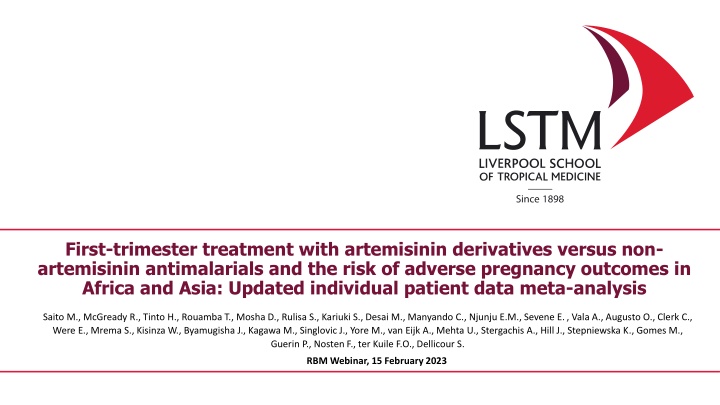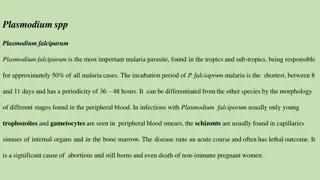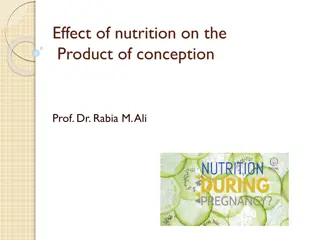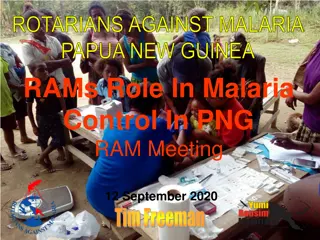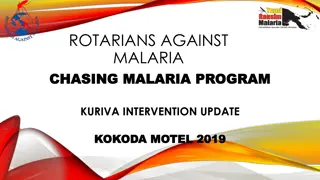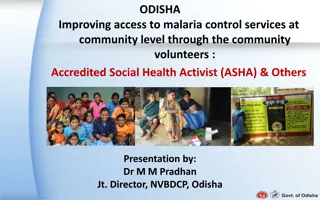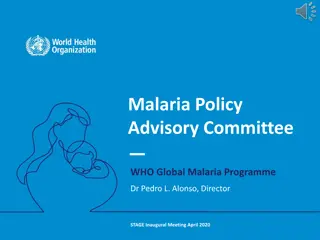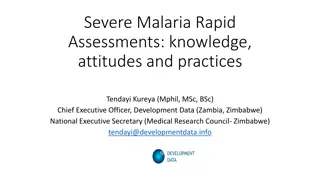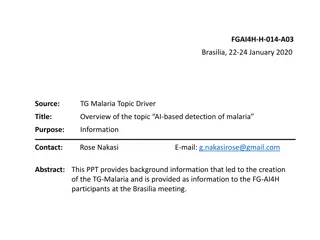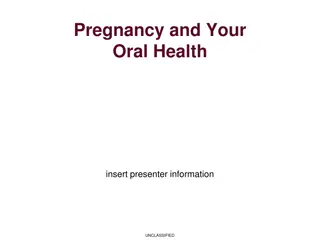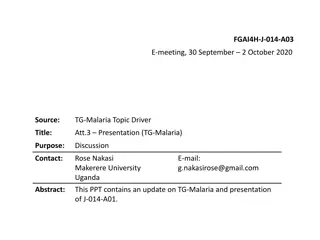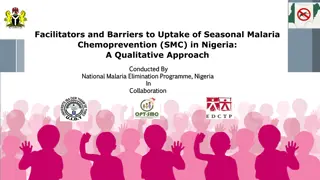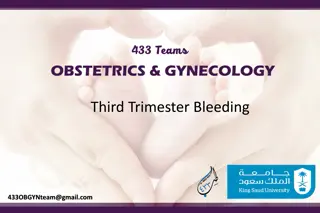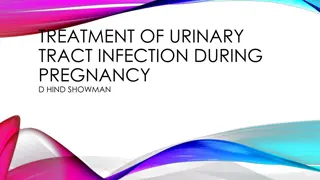Comparison of Artemisinin-Based vs. Non-Artemisinin Treatment in First-Trimester Malaria and Pregnancy Outcomes
Updated meta-analysis compares outcomes of artemisinin-based and non-artemisinin treatment in first-trimester malaria. Artemisinin considered safe in pregnancy, with WHO updates recommending artemether-lumefantrine (AL) in the first trimester. Study aims to assess risk of adverse pregnancy outcomes with artemisinin exposure in early pregnancy. Design includes systematic review, individual patient data, and outcomes of miscarriage, stillbirth, and congenital anomalies.
Download Presentation

Please find below an Image/Link to download the presentation.
The content on the website is provided AS IS for your information and personal use only. It may not be sold, licensed, or shared on other websites without obtaining consent from the author.If you encounter any issues during the download, it is possible that the publisher has removed the file from their server.
You are allowed to download the files provided on this website for personal or commercial use, subject to the condition that they are used lawfully. All files are the property of their respective owners.
The content on the website is provided AS IS for your information and personal use only. It may not be sold, licensed, or shared on other websites without obtaining consent from the author.
E N D
Presentation Transcript
First-trimester treatment with artemisinin derivatives versus non- artemisinin antimalarials and the risk of adverse pregnancy outcomes in Africa and Asia: Updated individual patient data meta-analysis Saito M., McGready R., Tinto H., Rouamba T., Mosha D., Rulisa S., Kariuki S., Desai M., Manyando C., Njunju E.M., Sevene E., Vala A., Augusto O., Clerk C., Were E., Mrema S., Kisinza W., Byamugisha J., Kagawa M., Singlovic J., Yore M., van Eijk A., Mehta U., Stergachis A., Hill J., Stepniewska K., Gomes M., Guerin P., Nosten F., ter Kuile F.O., Dellicour S. RBM Webinar, 15 February 2023
WHO Review of evidence on artemisinin safety in pregnancy WHO reviews: 2 informal consultations 2002 and 2006 > insufficient evidence to change policy recommendations. Evidence Review Group and Malaria Policy Advisory Committee Meetings in 2015 > recommended update to include ACT as an option in 1st trimester but not adopted by WHO. Guideline Development Group in 2022 > recommended update to include AL as preferred option in 1st trimester implemented in Nov 2022.
Research in context ACTs Quinine + Clindamycin Lengthy and complex treatment regimen (8- hourly for 7 days) Not well tolerated Poor adherence and treatment failure Quinine monotherapy mostly used Only used for 1st trimester population Shorter treatment course (3 vs 7 days for quinine) Better tolerated Longer post-treatment prophylaxis Better gametocidal property -> reduce onwards transmission Better efficacy (demonstrated in 2nd/3rd trimester & non-pregnant populations) 2nd/3rd trimester, PCR corrected treatment failure risk for quinine vs AL : adjusted HR 6.11 (95%CI: 2.57 14.54) From Saito et al 2020 Lancet Inf Dis, 20(8)
Study aim To compare the risk of adverse pregnancy outcomes between artemisinin-based (ABT) and non-artemisinin treatment (non-ABT) of malaria in the 1st trimester and the suggested artemisinin embryo-sensitive period
Study Design and Methods Updated systematic review and individual patient data (IPD) meta-analysis Study inclusion Confirmed artemisinin exposures in 1st trimester Prospective follow-up Internal comparison group Antimalarial exposures: 1st trimester: 2-13 weeks (inclusive) post-LMP Artemisinin embryo-sensitive period: 6-12 weeks (inclusive) post-LMP Exposures confirmed by >=2 data sources and/or medical record Outcome: Primary: composite endpoint including miscarriage, stillbirth and major congenital anomalies
Statistical analysis Primary analysis: ABT vs non-ABT Subgroup analysis: specific ACT vs quinine IPD: 1-stage random-effects adjusting for clustering by study site Cox regression with shared frailty Gestational week as the time scale Left truncated Right censoring Exposure time-dependant Sensitivity analyses E-values to assess potential unmeasured confounding Using unexposed comparison group Assessing smaller exposure risk-windows Inclusion of unconfirmed exposures Different statistical models Multiple imputations of missing data
Results Results
Result- Literature Search 7 included studies (12 cohorts) with 1st trimester artemisinin data 6 studies from Africa and 1 from Asia 34,178 pregnancies 1,813 (5%) confirmed antimalarial in 1st trimester 737 (2%) ABT: 74% Africa & 71% AL 1,076 (3%) non-ABT: 25% Africa & 85% Quinine Addition to 2017 review: 8,126 pregnancies 60 ABT 1st trimester exposures 309 non-ABT 1st trimester exposures
Result- Congenital anomalies Congenital anomaly subgroup First trimester Embryo-sensitive period ABT (n=623) Non ABT (n=681) Unexposed (n=26270) ABT (n=503) Non ABT (n=558) *1 case of cleft lip and palate and 1 case of bilateral syndactyly. ** 1 case of bilateral syndactyly and 1 case imperforated anus. Any major congenital anomaly Cases with multiple congenital anomalies 2* (0.32%) 8 (1.17%) 182 (0.69%) 2** (0.40%) 8 (1.43%) 0 (0%) 1 (0.15%) 36 (0.14%) 0 (0%) 1 (0.18%) Nervous system Eye Ear, face and neck Congenital heart defects Oro-facial clefts Digestive system Abdominal wall defects Urinary Genital Limb Other anomalies / syndromes 0 (0%) 0 (0%) 0 (0%) 0 (0%) 0 (0%) 0 (0%) 27 (0.10%) 8 (0.03%) 13 (0.05%) 0 (0%) 0 (0%) 0 (0%) 0 (0%) 0 (0%) 0 (0%) 0 (0%) 1 (0.15%) 15 (0.07%) 0 (0%) 1 (0.18%) Studies were not designed to systematically screen and detect congenital heart defects. 1 (0.16%) 0 (0%) 0 (0%) 0 (0%) 0 (0%) 1 (0.16%) 2 (0.29%) 0 (0%) 0 (0%) 0 (0%) 0 (0%) 5 (0.73%) 30 (0.12%) 20 (0.08%) 10 (0.04%) 4 (0.02%) 8 (0.03%) 46 (0.18%) 0 (0%) 1 (0.20%) 0 (0%) 0 (0%) 0 (0%) 1 (0.20%) 2 (0.36%) 0 (0%) 0 (0%) 0 (0%) 0 (0%) 5 (0.90%) 0 (0%) 1 (0.15%) 24 (0.10%) 0 (0%) 1 (0.18%) Cases with anomalies excluded from EUROCAT subgroups 0 (0%) 0 (0%) 3 (0.01%) 0 (0%) 0 (0%)
Conclusions No difference in risk of stillbirth, miscarriage or major congenital anomalies in confirmed ABT exposure vs non-ABT antimalarials considered safe in the 1st trimester - excludes a 1.03-fold and 1.45-fold increase in adverse pregnancy outcomes with ABT vs non-ABT in the 1st trimester and embryo-sensitive period 1st trimester AL Rx associated with a 42% lower risk of adverse pregnancy outcomes compared to quinine (aHR: 0.58, 95%CI 0.36- 0.92) The benefit-risk favours the use of AL over quinine for confirmed malaria in the 1st trimester of pregnancy based on the evidence for safety, efficacy, tolerability, and adherence Targeted surveillance needed to be able to detect signals for specific congenital anomalies
Acknowledgements All study participants and study teams IPD contributors and co-authors Birth Defect Panel set up for the WHO Pregnancy Registry pilot studies WWARN Funders of meta-analysis: Medicines for Malaria Venture (MMV) and the World Health Organization (WHO)
